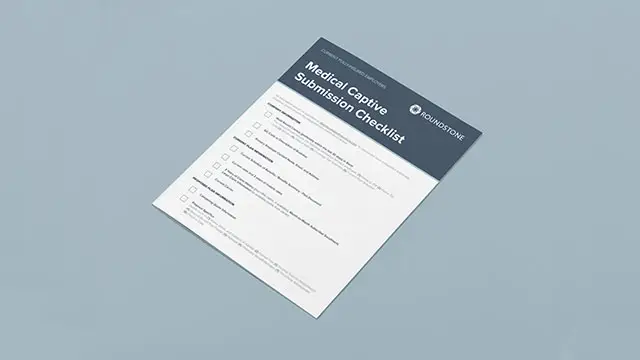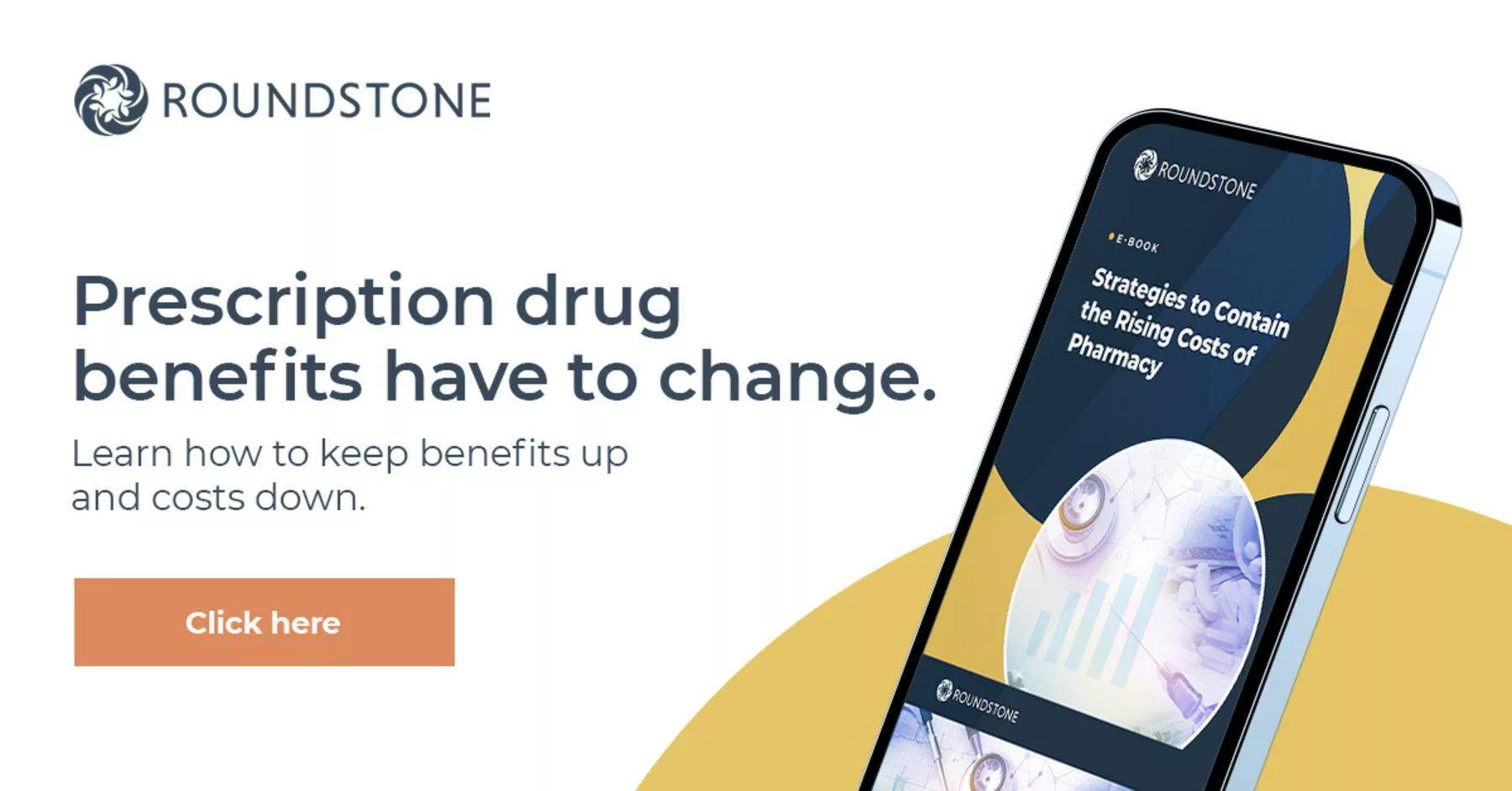Highlights
- Prescription drug costs continue to rise, with the price of specialty drugs negatively impacting healthcare expenses for small to midsize businesses.
- Several trends are emerging for managing costs in pharma, including switching to a self-funded plan for better budget control.
- With self-funded health insurance, you can use a pass-through pharmacy benefits manager to see more savings on medications and use biosimilars to cut costs.
- Cost containment measures like prior authorization and step therapy can be written into your flexible self-funded plan design to help reduce pharmacy spending.
Note: This article is based on information presented in our on-demand Summer Breeze webinar Emerging Trends for Managing Costs in Pharma. We would like to thank the presenters: Aaron Searls, VP of Business Development for TrueRx; Francine Taylor, Pharmacy Market Director at Cigna; Justin Jasniewski, CEO of Serve You Rx; Rob Hamilton, EVP of Sales at Roundstone; and Daniel Demyan, Cost Containment Strategist at Roundstone.
The Problem: The Escalating Cost of Prescription Drugs
Addressing rising pharmacy costs is a major concern for small to midsize businesses (SMBs). Specialty drugs are driving much of the cost, not only affecting health insurance premiums — but also impacting the member’s ability to afford them.
However, new trends in managing these costs are emerging. Through cost containment measures like switching to self-funding and proactive health plan design, employers can lower the cost of pharma, increase savings, and provide better care for their employees. With self-funding, it is even possible to simultaneously lower pharmacy spend while improving care quality — it’s about transparency and control.
The following insights from our Summer Breeze webinar explore these new trends, showcasing the benefits of self-funding with Roundstone in managing pharmacy costs for your organization.

Emerging Trends: A Glimmer of Hope
The escalating costs of specialty medications have become an unmanageable burden for many small to midsize employers. For many, high-priced prescriptions make up 60% to 80% of an employer’s total pharmacy spend.
Compounding the problem, drug manufacturers are permitted to change the list prices of their medications any time after launch. Last year, more than 4,200 drug products had price increases, of which 46% were larger than the rate of inflation. The average increase was 46.2%, or about $590 per drug.
However, signs of change are on the horizon. For example, the strategic decision by Blue Cross Blue Shield of California to part ways with CVS Caremark could cut annual drug costs by up to $500 million, promising savings for consumers.
At the federal level, the Biden Administration’s initiative to negotiate the prices of certain specialty drugs is projected to save Medicare nearly $100 billion over a decade.
These shifts and the emerging trends detailed below create opportunities for SMBs to better manage the soaring costs of prescription medications. And those enrolled in a self-funded insurance plan are in a great position to make the most of the savings opportunities represented by these evolving trends.

The Self-Funded Plan: A Viable Solution to Controlling Pharmacy Spend
Switching to a self-funded healthcare plan can be smart for employers facing high-cost medications. A self-funded plan allows you to pay for healthcare costs directly, only paying for actual claims rather than a fixed premium to an insurance carrier.
Self-funding offers more control and flexibility over plan design, letting you tailor your coverages to specific pharmacy needs and explore cost containment strategies more effectively.
For example, if an employer is fully insured and then moves into a self-funded platform where they receive pharmacy rebates, they could save $20 to $30 per employee per month.
Without the freedom to implement cost containment measures, you may be stuck with outrageous pricing structures for high-cost medications for employees. If you have a $40,000-a-year employee whose medication costs $125,000 annually and you can’t cut costs, they are effectively a $165,000-a-year employee, which can cut into your bottom line.
With a self-funded plan from Roundstone, you can explore real-world cost containment options to lower your pharma expenses.
For instance, a client initially paid for a high-cost medication for an employee, costing them around $125,000 to $130,000 annually. They explored cost containment strategies a few months after transitioning to a self-funded plan. They considered excluding the high-cost drug from coverage and looked into alternative options like advocacy services and patient assistance programs.
With these strategies in place, the employee was able to get the medication at no cost. This eliminated copays and coinsurance and cut pharma expenses for our client.
Flexible Plan Design: Tailoring to Needs
Adopting a flexible plan design in healthcare management is not just innovative — it’s critical for companies looking to control soaring healthcare costs without compromising patient care.
With a flexible self-funded health insurance plan, you can incorporate well-managed clinical programs and use strategic incentives to promote employee adherence and cost-saving behavior. When effectively implemented, this proactive approach can result in substantial savings for your company.
One of the biggest strains on healthcare resources and employer healthcare spending is diabetes management. The disease affects approximately 37.3 million Americans, making it likely that most companies have at least one person with diabetes on their payroll.
A flexible approach to benefits design through a self-funded health insurance plan can help you save on diabetes medication without reducing patient care.
For example, a non-profit organization, which spent almost a third of its healthcare budget on diabetes medication and management, partnered with Roundstone to develop a more flexible plan. This included a comprehensive diabetes management program with incentives to ensure patients followed their medication routines. These incentives included zero-dollar copays for commonly used generic diabetes drugs.
Members were also directed to more cost-efficient options like mail-order pharmacies and were given manufacturer copay cards for additional savings. By closely monitoring patient adherence and removing barriers to care, the program saved over 30% on their diabetes prescription spending year over year.
Biosimilars: The Cost-Effective Alternative
Encouraging the use of biosimilars with your pharmacy plan can be a strategic move to curb healthcare costs while maintaining the well-being of your employees.
A biosimilar is essentially a generic counterpart to a biologic drug, created from living organisms, serving as a cost-effective alternative to brand-name drugs like Humira, commonly used for conditions such as arthritis and Crohn’s disease.
Biosimilars are fantastic for everyone because they create competition in the marketplace. This creates potential savings for employers and members using these medications.
The availability of biosimilars like Hadlima, Hyrimoz, and Yuflyma has already spurred competition, ushering in cost savings for employers and patients alike, especially those under self-funded healthcare plans.
With more biosimilars slated to hit the market, the horizon is bright with potential for further cost containment. Even higher-cost drugs like Stelara have biosimilar alternatives.
Partnering with your Pharmacy Benefit Manager (PBM) or advisor can help navigate the use of biosimilars within your self-funded plan. They can analyze your current pharmaceutical spending and identify opportunities where biosimilars could be introduced to yield cost savings.
A pass-through or transparent PBM helps ensure the use biosimilars to save money in your self-funded plan. They pass on all discounts and rebates from drug makers directly to you and your employees. This transparent pricing model can boost savings, making biosimilars a practical choice to manage your drug costs.

Proactive Measures: Prior Authorization, Step Therapy, and More
Employing strategies like prior authorization, step therapy, and quantity limits will help you proactively manage pharmacy costs. These strategies can ensure medications are used correctly, preventing unnecessary spending.
Here’s how they work:
- Prior authorization. Before approving a medication for coverage under your plan, the necessity and appropriateness of the drug are reviewed based on established guidelines. The process helps to ensure that the prescribed medication is cost-effective and medically necessary. Prior authorization can be essential with newer classes of drugs like GLP-1 agonists, used for managing type 2 diabetes and weight loss. If you don’t have prior authorization, you’re opening up the potential for misuse of those medications for off-label purposes like weight loss, which could drive up your healthcare costs.
- Step therapy. This strategy involves trying cost-effective medications before moving to more expensive or riskier ones. If the less expensive medication works, costs are contained while the employee continues to get great healthcare.
- Quantity limits. This limits the amount of medication covered per prescription or within a specific time frame, ensuring its use is within safe and approved guidelines, which helps to control costs and to prevent misuse or overuse of medications.
With a self-funded health insurance plan, you can work these safeguards into your benefits design from the beginning. This helps you set the stage for medication approvals with your employees, communicate expectations when they sign up for benefits, and prevent excess spending year over year.
Roundstone: Your Partner in Cost Management
Roundstone is an innovative employee health benefits company. We help small and midsize organizations offer competitive benefits at a lower cost by self-funding health insurance through our group medical captive.
The Roundstone Captive enables companies to self-insure safely by pooling hundreds of employers together to share risk and save money. It effectively allows a company with only 25 employees to self-fund their health insurance with the same confidence as the Fortune 500s.
With easy onboarding and personalized support every step of the way, the captive offers control, flexibility, and transparency and returns all savings back to employers — where they belong.
We believe in always aligning with the employers’ best interests and remain committed to our mission — quality, affordable healthcare and a better life for all.
Learn More
Prescription drug benefits have to change. Employers can no longer afford the status quo. You can take steps to limit the effect on your bottom line by switching to a self-funded group captive with Roundstone.
For more information on how you can reduce your pharmacy spend, download our free ebook below.
To learn more about joining a self-insured group captive plan with Roundstone, contact a customer relations manager today to discover how self-funding can give you the freedom to control pharmacy spending and provide a better life for all.












